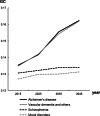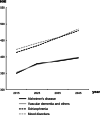Projections of psychiatrists' distribution for patients in Japan: a utilization-based approach
- PMID: 33836799
- PMCID: PMC8033670
- DOI: 10.1186/s12960-021-00594-z
Projections of psychiatrists' distribution for patients in Japan: a utilization-based approach
Abstract
Background: Depopulation accompanied by population aging is a major public health concern in Japan. Although adequate allocation of mental healthcare resources is needed, there have been few studies on the impact of population change on the supply-demand balance for mental illness in Japan. The aim of this study is to predict psychiatrists' distribution for patients with mental illness via a utilization-based approach.
Methods: We set patients with schizophrenia, mood disorders, vascular dementia or Alzheimer's disease as study subjects and conducted analyses for 2015, 2025, 2035, and 2045 across all prefectures. Moreover, we evaluated the regional maldistribution of demand and supply by calculating the number of psychiatrists per patient, Gini coefficients (GC), and Herfindahl-Hirschman Index (HHI).
Results: The mean number of psychiatrists per patient for patients with schizophrenia, mood disorders, vascular dementia, and Alzheimer's disease in 2025, 2035, and 2045 was significantly lower than in 2015. For all of the abovementioned diseases, both the GC and HHI will increase until 2045.
Conclusion: If psychiatrists are allocated at the current population-to-psychiatrist ratio, the shortage of psychiatrists will continue to worsen in the future. To overcome this inequity, policy makers should make plans to shift responsibilities from psychiatrists to other mental health workers and to ensure the adequate geographical allocation of healthcare resources.
Keywords: Demand–supply balance; Forecasting; Maldistribution; Utilization-based approach.
Conflict of interest statement
The authors declare that they have no competing interests.
Figures
Similar articles
-
Forecasting maldistribution of human resources for healthcare and patients in Japan: a utilization-based approach.BMC Health Serv Res. 2019 Sep 9;19(1):653. doi: 10.1186/s12913-019-4470-x. BMC Health Serv Res. 2019. PMID: 31500619 Free PMC article.
-
Effects of the 2004 postgraduate training program on the interprefectural distribution of psychiatrists in Japan.Psychiatry Clin Neurosci. 2015 Feb;69(2):117-21. doi: 10.1111/pcn.12219. Epub 2014 Aug 21. Psychiatry Clin Neurosci. 2015. PMID: 25041172
-
A gap analysis for future supply of and demand for psychiatrists in Austria.J Ment Health Policy Econ. 2014 Mar;17(1):9-18. J Ment Health Policy Econ. 2014. PMID: 24864117
-
The future of psychiatry in low- and middle-income countries.Psychol Med. 2009 Nov;39(11):1759-62. doi: 10.1017/s0033291709005224. Psychol Med. 2009. PMID: 20162837 Review.
-
The impact of managed care on psychiatry.Adm Policy Ment Health. 1998 Nov;26(2):149-57. doi: 10.1023/a:1021254428299. Adm Policy Ment Health. 1998. PMID: 10205946 Review.
Cited by
-
Measuring inequality in the distribution of health human resources using the Hirschman-Herfindahl index: a case study of Qazvin Province.BMC Health Serv Res. 2022 Sep 14;22(1):1161. doi: 10.1186/s12913-022-08518-w. BMC Health Serv Res. 2022. PMID: 36104727 Free PMC article.
-
Examining the Effects of Cognitive Behavioral Therapy With a Virtual Agent on User Motivation and Improvement in Psychological Distress and Anxiety: Two-Session Experimental Study.JMIR Form Res. 2024 Oct 15;8:e55234. doi: 10.2196/55234. JMIR Form Res. 2024. PMID: 39405101 Free PMC article.
References
-
- Ministry of Health, Labour and Welfare: Patient survey (in Japanese). https://www.e-stat.go.jp/stat-search/files?page=1&toukei=00450022&tstat=.... Accessed 14 Jul 2020.
-
- National Institute of Population and Social Security Research: Population & Household Projection, 2018. (in Japanese). http://www.ipss.go.jp/pp-shicyoson/j/shicyoson18/t-page.asp. Accessed 14 Jul 2020
MeSH terms
LinkOut - more resources
Full Text Sources
Other Literature Sources
Medical
Miscellaneous




